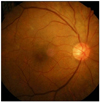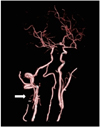Abstract
Purpose
To report a patient with ocular ischemic syndrome who suffered from sudden decrease in visual acuity after bevacizumab injection.
Case summary
A 70-year-old patient visited the Department of Ophthalmology due to progressively decreasing visual acuity in the right eye. Corrected visual acuity in his right eye was 0.1 on the first visit; ocular ischemic syndrome was suspected. Despite panretinal photocoagulation, severe iris neovascularization was still present in the right eye. Intravitreal bevacizumab injection was performed to regress the iris neovascularization. One day after injection, iris neovascularization regressed significantly, however, visual acuity was decreased to finger counting.
Figures and Tables
Figure 2
Fluorescein angiography of patient's right eye. (A) Early phase in fluorescein angiography shows delayed arm-to-retina time. (B) Early phase in fluorescein angiography shows delayed choroidal filling. (C) Late phase in fluorescein angiography shows incomplete fluorescein filling of retinal vein.

References
1. Sharma S, Brown GC. Ryan SJ, editor. Ocular ischemic syndrome. Retina. 2006. v. 2:4th ed. St. Louis: Mosby;chap. 84.
2. Brown GC, Magaral LE. The ocular ischemic syndrome. Clinical, fluorescein angiographic and carotid angiographic features. Int Ophthalmol. 1988. 11:239–251.
3. Avery RL. Regression of retinal and iris neovascularization after intravitreal bevacizumab (Avastin) treatment. Retina. 2006. 26:352–354.
4. Gheith ME, Siam GA, de Barros DS, et al. Role of intravitreal bevacizumab in neovascular glaucoma. J Ocul Pharmacol Ther. 2007. 23:487–491.
5. Chalam KV, Gupta SK, Grover S, et al. Intracameral Avastin dramatically resolves iris neovascularization and reverses neovascular glaucoma. Eur J Ophthalmol. 2008. 18:255–262.
6. Wakabayashi T, Oshima Y, Sakaguchi H, et al. Intravitreal bevacizumab to treat iris neovascularization and neovascular glaucoma secondary to ischemic retinal diseases in 41 consecutive cases. Ophthalmology. 2008. 115:1571–1580.
7. Amselem L, Montero J, Diaz-Llopis M, et al. Intravitreal bevacizumab (Avastin) injection in ocular ischemic syndrome. Am J Ophthalmol. 2007. 144:122–124.
8. Lee SJ, Lee JJ, Kim SY, Kim SD. Intravitreal bevacizumab (Avastin) treatment of neovascular glaucoma in ocular ischemic syndrome. Korean J Ophthalmol. 2009. 23:132–134.
9. Huang ZL, Lin KH, Lee YC, et al. Acute vision loss after intravitreal injection of bevacizumab (avastin) associated with ocular ischemic syndrome. Ophthalmologica. 2010. 224:86–89.
10. Kofoed PK, Munch IC, Larsen M. Profound retinal ischaemia after ranibizumab administration in an eye with ocular ischaemic syndrome. Acta Ophthalmol. 2010. 88:808–810.
11. Ferrara N, Hillan KJ, Gerber HP, Novotny W. Discovery and development of bevacizumab, an anti-VEGF antibody for treating cancer. Nat Rev Drug Discov. 2004. 3:391–400.
12. Avery RL, Pearlman J, Pieramici DJ, et al. Intravitreal bevacizumab (Avastin) in the treatment of proliferative diabetic retinopathy. Ophthalmology. 2006. 113:1695.
13. Kim NR, Chin HS. Progression of impending central retinal vein occlusion to the ischemic variant following intravitreal bevacizumab. Korean J Ophthalmol. 2010. 24:179–181.
14. Kim KS, Chang HR, Song S. Ischaemic change after intravitreal bevacizumab (Avastin) injection for macular oedema secondary to non-ischaemic central retinal vein occlusion. Acta Ophthalmol. 2008. 86:925–927.
15. Schutz FA, Je Y, Azzi GR, et al. Bevacizumab increases the risk of arterial ischemia: a large study in cancer patients with a focus on different subgroup outcomes. Ann Oncol. 2011. 22:1404–1412.
16. Peters S, Heiduschka P, Julien S, et al. Ultrastructural findings in the primate eye after intravitreal injection of bevacizumab. Am J Ophthalmol. 2007. 143:995–1002.
17. Shima C, Sakaguchi H, Gomi F, et al. Complications in patients after intravitreal injection of bevacizumab. Acta Ophthalmol. 2008. 86:372–376.




 PDF
PDF ePub
ePub Citation
Citation Print
Print




 XML Download
XML Download